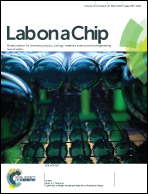HIV microarray for the mapping and characterization of HIV-specific antibody responses†
Abstract
We used the microarray technology to develop chips containing a comprehensive set of proteins and peptides covering the proteome of HIV-1 clade C, which is the HIV-1 subtype that causes the majority of infections worldwide. We demonstrate that the HIV microarray allows simultaneous, sensitive and specific detection of antibody responses for the major immunoglobulin classes (IgG, IgA, IgM, IgE) and subclasses (IgG1–4) with minute amounts of serum samples towards a large number of HIV antigens and peptides. Furthermore, we show that the HIV chip can be used for the monitoring of antibody responses during the course of the disease and during treatment. The HIV microarray should be useful to study antibody responses to multiple HIV antigens and epitopes in HIV-infected patients to explore pathomechanisms of the disease, for diagnosis and for monitoring of treatment and of vaccine trials.


 Please wait while we load your content...
Please wait while we load your content...